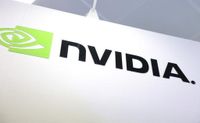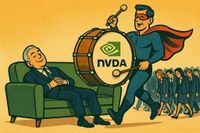Wall Street is holding its breath as Nvidia, the California-based chipmaking titan, prepares to unveil its latest quarterly earnings report—a financial event with the power to jolt not just the tech sector, but the entire U.S. stock market. Scheduled for release on Wednesday, August 27, 2025, this report is more than a routine update. It’s a litmus test for the ongoing artificial intelligence (AI) frenzy that has gripped investors, driven up valuations, and fueled debates about the sustainability of the current tech rally.
In the past two years, Nvidia has catapulted to the top of the corporate world, becoming the first publicly traded company to surpass a staggering $4 trillion market capitalization in July 2025. Since achieving that milestone, its stock price has soared another 13%, generating an additional $500 billion in shareholder wealth, according to the Associated Press. This meteoric rise has made Nvidia a bellwether for both the AI revolution and the broader stock market.
The anticipation surrounding Nvidia’s earnings is palpable. As reported by Al Jazeera, the company’s graphics processing units (GPUs)—including the flagship Blackwell B200—are the beating heart of the AI boom. These chips are the backbone of data centers powering generative AI models like OpenAI’s ChatGPT, which burst onto the scene in November 2022 and ignited a technology craze reminiscent of the iPhone’s 2007 debut.
Major tech players—Microsoft, Meta, Amazon, and Alphabet—are all deeply reliant on Nvidia’s chips. Their collective investment in AI infrastructure is expected to exceed $325 billion in 2025, a figure that underscores just how much is riding on the promise of artificial intelligence. Amazon alone has announced plans to spend $85 billion on AI in the coming year, while Microsoft’s outlay is projected to hit $100 billion.
Nvidia’s own financial performance has reflected this tidal wave of demand. For the fiscal year ending in late January 2025, the company posted annual revenue of $130.5 billion. More strikingly, it achieved triple-digit revenue growth for five consecutive quarters between mid-2023 and 2024, before settling into still-impressive high double-digit growth. Last quarter, Nvidia reported revenue of $44.1 billion, marking a 69% increase year-over-year.
For the current quarter—covering May through July 2025—analysts surveyed by FactSet predict Nvidia will earn $1.01 per share (excluding certain items), a 49% jump from the same period last year. Revenue is expected to rise 53% to about $46 billion, in line with the company’s own forecast of $45 billion, plus or minus 2%. These are numbers most companies can only dream of, yet there are signs the breakneck pace is beginning to slow. The projected growth rate is down from the 122% surge recorded during the same period last year.
Despite the euphoria, some investors are voicing caution. According to The Verge, OpenAI CEO Sam Altman recently questioned the sustainability of the AI craze, stating, “Are we in a phase where investors as a whole are overexcited about AI? My opinion is, yes.” Altman’s remarks have fueled comparisons to past market bubbles, including the infamous “Nifty Fifty” stocks of the 1970s and the dot-com boom that ended in a painful crash in 2000. Arun Sai, a senior strategist at Pictet Asset Management, drew a direct line to those episodes, noting, “This is the old notion of you could be a great company, but not a great stock if the price is wrong.”
Indeed, by some traditional metrics, Nvidia’s valuation appears frothy. The company is trading at roughly 40 times its future earnings—double the level many investors consider reasonable. That’s not an isolated phenomenon: Microsoft, another AI leader, is hovering just below a $4 trillion valuation, while Alphabet, Meta, and Amazon are all valued between $1.9 trillion and $2.5 trillion. The “Magnificent Seven”—a group that includes Nvidia, Microsoft, Alphabet, Amazon, Apple, Meta, and Tesla—have seen their combined valuations soar on the back of AI enthusiasm, though some, like Apple and Tesla, have recently lagged.
The stakes are high not just for Nvidia, but for the entire market. The company now makes up nearly 8% of the S&P 500 index, meaning its earnings swings can move the benchmark by a full percentage point or more. After Nvidia’s February 2025 earnings miss, its share price plummeted over 8%, dragging the S&P 500 down by 1.6%. As Bloomberg notes, the anticipation ahead of this week’s report has contributed to a 1.1% rise in Nvidia’s stock, helping buoy the S&P 500 and other major indexes. Investors are hoping for clarity not only on Nvidia’s performance, but also on how AI investments are translating into real-world profits.
Yet, there are reasons to be wary. A recent Massachusetts Institute of Technology (MIT) survey found that 95% of enterprises reported no return on their AI investments, despite billions spent. This sobering statistic has amplified concerns that the current AI boom could be more sizzle than steak. Corporate spending on AI is often likened to an arms race, but tech giants will eventually need to prove that their bets are paying off.
Adding to the uncertainty are geopolitical tensions, particularly with China. President Donald Trump’s trade war has made Nvidia’s business in the world’s largest semiconductor market a rollercoaster. In April 2025, Trump banned sales of Nvidia’s H20 chip—a product tailored specifically for China—costing the company an estimated $8 billion. The ban was lifted on August 11, 2025, after Nvidia agreed to share 15% of its H20 sales in China with the U.S. government. This compromise, finalized just two weeks after the end of Nvidia’s second quarter, is expected to be a focal point of CEO Jensen Huang’s conversation with analysts.
Wall Street remains perplexed by the company’s China exposure. As reported by Bloomberg, third-quarter revenue projections for Nvidia vary by as much as $15 billion—the widest spread in at least a decade—reflecting deep uncertainty about the impact of trade restrictions and regulatory risks. Investors are eagerly awaiting Huang’s insights on how these geopolitical headwinds might shape Nvidia’s future.
Meanwhile, the broader market is digesting a mixed bag of corporate results and macroeconomic signals. While Nvidia’s performance has driven optimism, other sectors have contributed to more modest gains. Advanced Micro Devices, a key competitor, recently received an upgrade from Truist Securities, and pharmaceutical giant Eli Lilly saw its stock surge on positive weight-loss pill data, highlighting the diversity of market drivers beyond tech.
With the Federal Reserve widely expected to begin cutting interest rates in September 2025, market sentiment is at an inflection point. Investors are looking to Nvidia’s earnings for reassurance that the AI boom is built on solid ground, not just hype. The outcome of Wednesday’s report could either reinforce the rally in AI-driven stocks or prompt a broader reevaluation of tech sector valuations.
Nvidia’s quarterly results, then, are more than just another set of numbers—they’re a referendum on the future of artificial intelligence, the resilience of the technology sector, and the direction of the global economy. As the world watches, the answer to whether we’re witnessing a sustainable technological revolution or the makings of another bubble may soon come into sharper focus.




